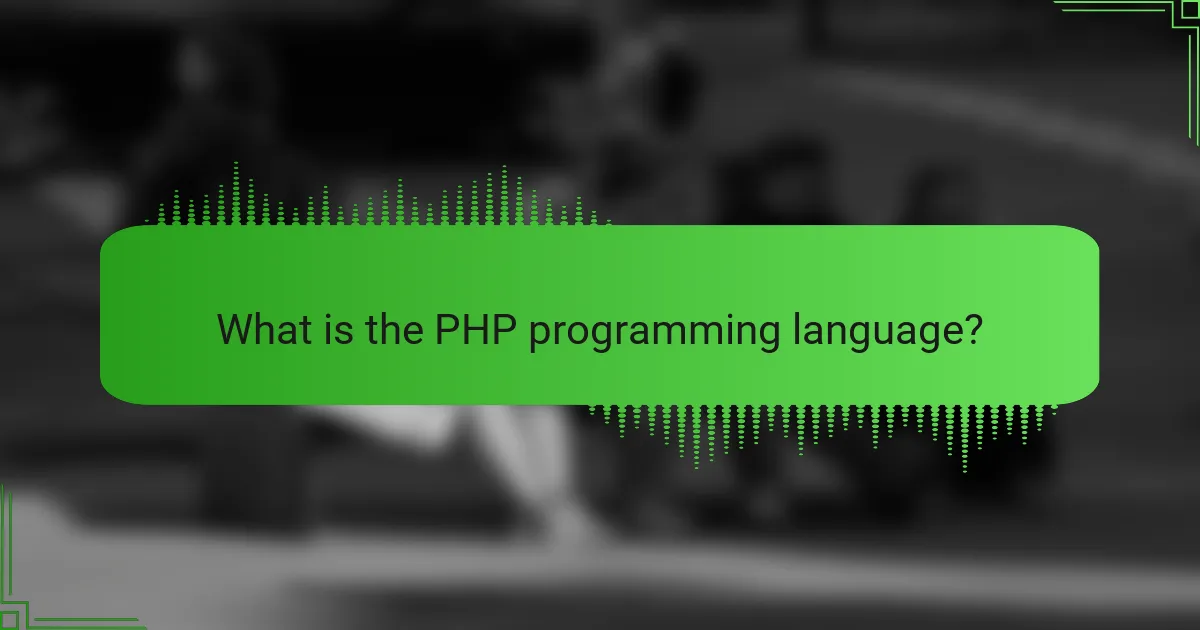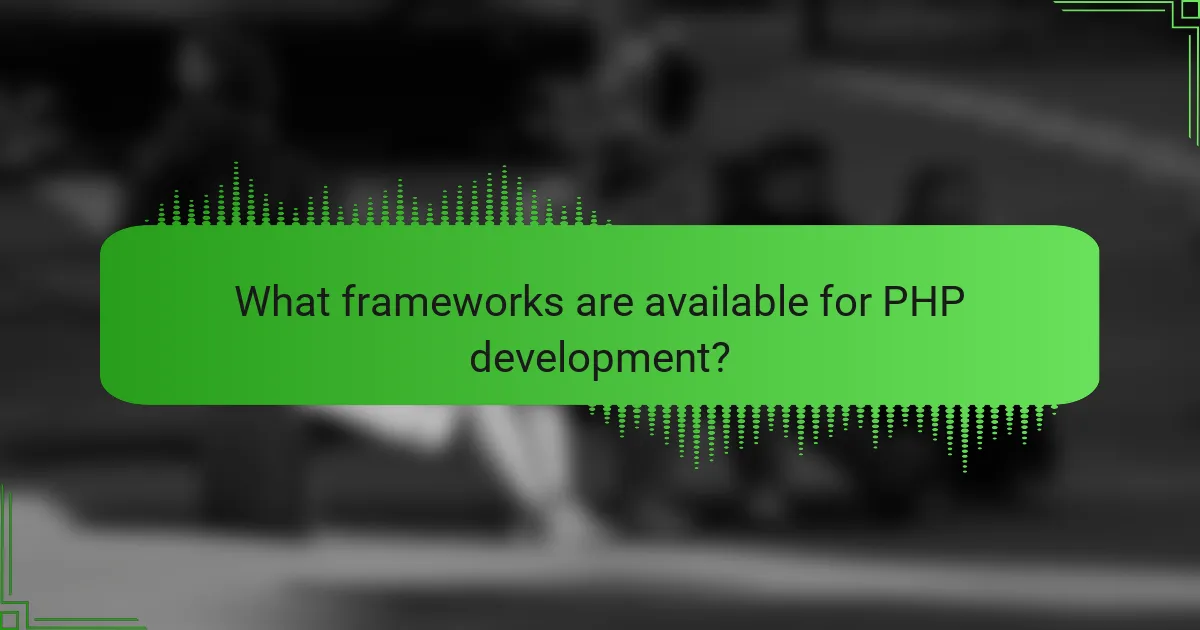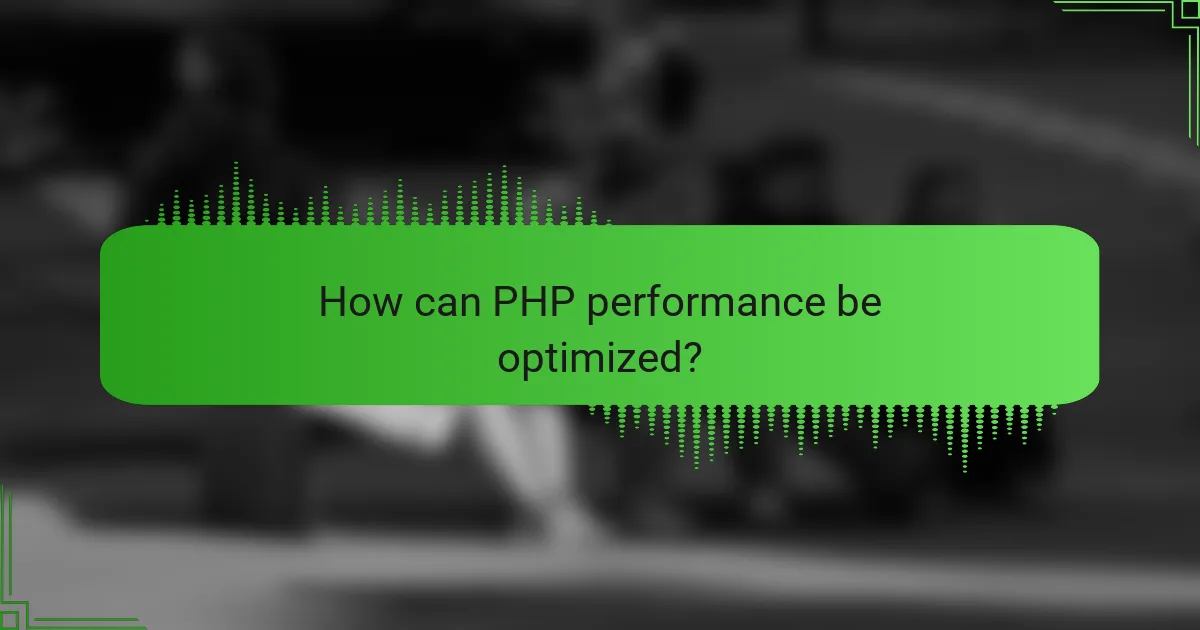PHP is a server-side scripting language primarily used for web development, enabling the creation of dynamic web pages and applications. Developed by Rasmus Lerdorf in 1994, PHP integrates seamlessly with databases like MySQL and powers over 79% of websites that utilize a known server-side programming language. This article explores various PHP frameworks, including Laravel, Symfony, CodeIgniter, Yii, and Zend Framework, highlighting their unique features and suitability for different development needs. Additionally, it addresses performance optimization techniques such as opcode caching, using a content delivery network (CDN), optimizing database queries, and leveraging built-in functions to enhance execution speed. The importance of keeping PHP and its extensions updated for security and performance improvements is also discussed.

What is the PHP programming language?
PHP is a server-side scripting language designed primarily for web development. It allows developers to create dynamic web pages and applications. PHP stands for “Hypertext Preprocessor.” It was created by Rasmus Lerdorf in 1994. PHP is widely used due to its ease of integration with databases, particularly MySQL. According to W3Techs, PHP powers over 79% of all websites with a known server-side programming language. The language supports various frameworks, enhancing its functionality and performance. PHP code can be embedded directly into HTML, simplifying the development process.
How does PHP function as a server-side scripting language?
PHP functions as a server-side scripting language by processing code on the server before sending the output to the client’s browser. It allows developers to create dynamic web pages that can interact with databases and handle user input. PHP code is embedded within HTML, enabling seamless integration of server-side logic with front-end presentation. When a user requests a PHP page, the server executes the PHP code, generating HTML content. This content is then sent to the user’s browser for display. PHP also supports various databases, such as MySQL, enhancing its functionality for data-driven applications. According to W3Techs, PHP powers over 79% of all websites using a server-side language, demonstrating its widespread adoption and reliability in web development.
What are the key features that differentiate PHP from other programming languages?
PHP is distinguished from other programming languages by its ease of integration with HTML. This allows developers to embed PHP code directly into web pages. PHP is designed for web development, making it a server-side scripting language. It supports a wide range of databases, enhancing its versatility. PHP is open-source, which means it’s free to use and has a large community for support. Its extensive library of built-in functions accelerates development. PHP is also known for its flexibility, allowing for various coding styles. These features contribute to PHP’s popularity in web development compared to other programming languages.
How does PHP handle server requests and responses?
PHP handles server requests and responses through a request-response cycle. When a client sends a request, the server receives it via the web server software. PHP processes the request by executing the relevant script. During execution, PHP can access request data such as GET and POST variables. The script generates a response, typically in HTML format. This response is then sent back to the client through the web server. PHP also manages session data, allowing for stateful interactions. This process is efficient, enabling dynamic content generation on websites.
What are the primary uses of PHP in web development?
PHP is primarily used for server-side scripting in web development. It enables dynamic content generation and database interaction. PHP powers content management systems like WordPress. It is also utilized for building web applications and e-commerce platforms. PHP supports various frameworks, enhancing development speed and efficiency. Popular frameworks include Laravel and Symfony. PHP can handle session management and user authentication. It is widely adopted due to its ease of integration with HTML and databases.
Which types of applications are commonly built using PHP?
Web applications are commonly built using PHP. Content management systems like WordPress and Joomla are popular examples. E-commerce platforms such as Magento and WooCommerce utilize PHP for backend operations. Social networking sites often leverage PHP for user interaction features. PHP is also used in forums and community websites, providing dynamic content. Additionally, it is employed in web-based applications for data management and reporting. According to W3Techs, PHP powers over 79% of all websites with a known server-side programming language. This widespread usage underscores PHP’s versatility in developing various application types.
How does PHP integrate with databases?
PHP integrates with databases primarily through extensions like MySQLi and PDO. These extensions allow PHP to connect, query, and manipulate data within a database. MySQLi stands for MySQL Improved and provides a procedural and object-oriented interface. PDO, or PHP Data Objects, offers a consistent method for accessing databases, supporting multiple database systems.
To establish a connection, PHP uses specific functions provided by these extensions. For example, MySQLi uses `mysqli_connect()` to connect to a MySQL database. Similarly, PDO uses the `new PDO()` constructor for database connections.
Once connected, PHP can execute SQL queries using functions like `mysqli_query()` for MySQLi. For PDO, the method `prepare()` is used to prepare SQL statements. This allows for secure execution of queries with bound parameters, reducing the risk of SQL injection.
Data retrieval is straightforward. PHP can fetch results using functions like `mysqli_fetch_assoc()` or `fetch()` in PDO. These functions convert database rows into associative arrays or objects, making it easy to work with the data in PHP.
In summary, PHP integrates with databases through specific extensions that facilitate connection, querying, and data manipulation, ensuring secure and efficient database interactions.

What frameworks are available for PHP development?
Laravel, Symfony, CodeIgniter, Yii, and Zend Framework are available for PHP development. Laravel is known for its elegant syntax and robust features. Symfony offers a set of reusable PHP components and a strong community. CodeIgniter is lightweight and easy to install, making it suitable for beginners. Yii is designed for high-performance applications and includes powerful caching support. Zend Framework is enterprise-ready and provides extensive tools for building secure applications. These frameworks support rapid development and enhance the efficiency of PHP programming.
How do PHP frameworks enhance development efficiency?
PHP frameworks enhance development efficiency by providing pre-built modules and libraries. These frameworks streamline repetitive tasks, reducing the amount of code developers need to write. They also promote best practices and coding standards, which improves code quality. Frameworks often include built-in security features, saving time on implementing security measures. Furthermore, they facilitate faster development cycles through tools for testing and debugging. According to a survey by JetBrains, 66% of PHP developers reported increased productivity when using frameworks. This demonstrates that PHP frameworks significantly contribute to more efficient development processes.
What are the most popular PHP frameworks and their unique features?
Laravel, Symfony, CodeIgniter, and Yii are among the most popular PHP frameworks. Laravel is known for its elegant syntax and built-in ORM, Eloquent. Symfony offers a modular structure and reusable components, making it highly customizable. CodeIgniter is lightweight and easy to set up, ideal for beginners. Yii stands out for its performance and security features, including built-in authentication. Each framework serves different needs, catering to various levels of complexity and developer expertise.
How do frameworks like Laravel and Symfony compare?
Laravel and Symfony are both popular PHP frameworks, but they differ in structure and usage. Laravel emphasizes simplicity and ease of use, making it ideal for rapid application development. Symfony is more flexible and modular, suited for complex applications requiring customization. Laravel has a built-in ORM called Eloquent, while Symfony uses Doctrine for database interactions. Laravel’s routing system is intuitive and straightforward, whereas Symfony offers a more robust routing configuration. Symfony has a steeper learning curve due to its extensive features, while Laravel is more beginner-friendly. Both frameworks support MVC architecture, but Laravel is often preferred for smaller projects, and Symfony is favored for large-scale applications.
What should developers consider when choosing a PHP framework?
Developers should consider several key factors when choosing a PHP framework. First, they should evaluate the framework’s performance and speed. Frameworks like Laravel and Symfony are known for their efficiency. Next, developers must assess community support and documentation. A strong community can provide resources and assistance. Additionally, compatibility with existing systems is crucial. The framework should integrate smoothly with current technologies. Security features are also important; frameworks should offer built-in protection against common vulnerabilities. Developers should consider the learning curve associated with the framework. A steeper learning curve may require more time for team training. Finally, scalability is vital for future growth. The chosen framework should accommodate increasing traffic and functionality. These considerations ensure developers select a PHP framework that meets their project needs effectively.
What are the performance implications of different frameworks?
Different frameworks can significantly impact the performance of PHP applications. Frameworks like Laravel, Symfony, and CodeIgniter vary in their resource consumption and execution speed. Laravel tends to have a higher overhead due to its extensive features, which can slow down performance in high-traffic scenarios. Symfony, while powerful, can also introduce latency because of its flexibility and component-based architecture. CodeIgniter is lightweight and generally faster, making it suitable for simpler applications.
Performance benchmarks show that applications built with CodeIgniter can handle more requests per second compared to those using Laravel or Symfony. For example, a study by PHP Performance Benchmark reported that CodeIgniter processed up to 30% more requests under the same server conditions.
Ultimately, the choice of framework should align with the application’s complexity and performance requirements.
How does community support influence framework selection?
Community support significantly influences framework selection by providing resources, guidance, and collaboration opportunities. A strong community offers extensive documentation, tutorials, and forums that facilitate learning and troubleshooting. This support reduces the learning curve for new developers and enhances overall productivity. Additionally, active communities often contribute to the framework’s development, ensuring timely updates and feature enhancements. Research indicates that frameworks with robust community backing tend to have higher adoption rates. For instance, Laravel, a PHP framework, has a vibrant community that contributes to its popularity and usability.

How can PHP performance be optimized?
PHP performance can be optimized through various techniques. Utilizing opcode caching, such as OPcache, reduces script execution time by storing precompiled script bytecode in memory. Implementing a content delivery network (CDN) can decrease load times by distributing content closer to users. Optimizing database queries enhances performance by reducing response times and minimizing load on the server. Using PHP’s built-in functions instead of custom code can lead to faster execution due to their optimization in the core. Profiling code with tools like Xdebug identifies bottlenecks, allowing targeted improvements. Lastly, keeping PHP and its extensions updated ensures access to performance enhancements and security fixes.
What are common performance bottlenecks in PHP applications?
Common performance bottlenecks in PHP applications include inefficient database queries, excessive memory usage, and slow file I/O operations. Inefficient database queries can lead to slow response times, particularly when using unoptimized joins or missing indexes. Excessive memory usage may occur due to large data sets or poorly managed sessions, resulting in slower processing speeds. Slow file I/O operations can happen when reading from or writing to files, especially if the file system is not optimized. Additionally, reliance on synchronous operations can block execution, further impacting performance. Each of these factors can significantly degrade the overall efficiency of PHP applications.
How does code quality affect PHP performance?
Code quality significantly affects PHP performance. High-quality code is efficient and reduces execution time. Poor code can lead to increased memory usage and slower response times. For instance, unoptimized queries can slow down database interactions. Additionally, code that lacks proper error handling may cause failures that impact performance. According to a study by the University of Alberta, well-structured code can improve execution speed by up to 40%. Thus, maintaining high code quality is essential for optimal PHP performance.
What role do caching mechanisms play in optimization?
Caching mechanisms significantly enhance optimization by reducing data retrieval times. They store frequently accessed data in a temporary storage area. This minimizes the need to fetch data from slower sources, such as databases or external APIs. As a result, applications respond faster to user requests. Caching can improve server performance by decreasing the workload on databases. Studies show that implementing caching can lead to performance improvements of up to 90%. Popular caching systems, like Redis and Memcached, are widely used in PHP applications to boost efficiency.
What best practices should developers follow for optimizing PHP applications?
Developers should follow several best practices for optimizing PHP applications. First, they should utilize opcode caching to improve performance. Tools like OPcache can significantly reduce script execution time. Second, developers should minimize file I/O operations. Reading from files can be slow, so caching data in memory is beneficial. Third, they should optimize database queries. Using prepared statements and indexing can enhance database performance. Fourth, developers should avoid using global variables. This practice can lead to increased memory usage and slower performance. Fifth, they should implement proper error handling. This can prevent application crashes and improve user experience. Finally, they should keep PHP and libraries updated. Newer versions often include performance improvements and security fixes. Following these practices can lead to faster and more efficient PHP applications.
How can profiling tools help identify performance issues?
Profiling tools help identify performance issues by analyzing code execution and resource usage. They provide insights into function call durations, memory consumption, and database query performance. This information allows developers to pinpoint bottlenecks in the code. For example, tools like Xdebug can reveal which functions take the longest to execute. Additionally, profiling tools can highlight inefficient database queries that slow down applications. By using these insights, developers can optimize their code for better performance. Studies show that effective profiling can reduce application response times significantly, enhancing user experience.
What are effective strategies for minimizing load times?
Effective strategies for minimizing load times include optimizing images, leveraging browser caching, and minimizing HTTP requests. Optimizing images can reduce their size without compromising quality. Tools like TinyPNG can compress images effectively. Leveraging browser caching allows frequently accessed resources to be stored locally, which speeds up load times for returning visitors. Minimizing HTTP requests can be achieved by combining CSS and JavaScript files. This reduces the number of files the server must retrieve. Using a Content Delivery Network (CDN) can also enhance load times by distributing content closer to users. According to Google, optimizing these elements can lead to significant improvements in page speed, enhancing user experience and SEO rankings.
What are the common troubleshooting tips for PHP performance issues?
Common troubleshooting tips for PHP performance issues include optimizing code, using caching mechanisms, and profiling applications. Optimizing code involves reducing complexity and eliminating unnecessary computations. Caching mechanisms, such as opcode caching and data caching, can significantly speed up execution times. Profiling applications helps identify bottlenecks and inefficient code paths. Tools like Xdebug and Blackfire can assist in this process. Additionally, ensuring the server environment is properly configured can enhance performance. Regularly updating PHP to the latest stable version also provides performance improvements and security enhancements.
PHP is a server-side scripting language primarily used for web development, enabling the creation of dynamic web pages and applications. The article covers PHP’s functionality, key features, and its widespread adoption, powering over 79% of websites with known server-side languages. It also explores PHP’s integration with databases, popular frameworks like Laravel and Symfony, and best practices for optimizing performance. Additionally, the content addresses common performance bottlenecks and troubleshooting tips, emphasizing the importance of code quality and caching mechanisms in enhancing application efficiency.


